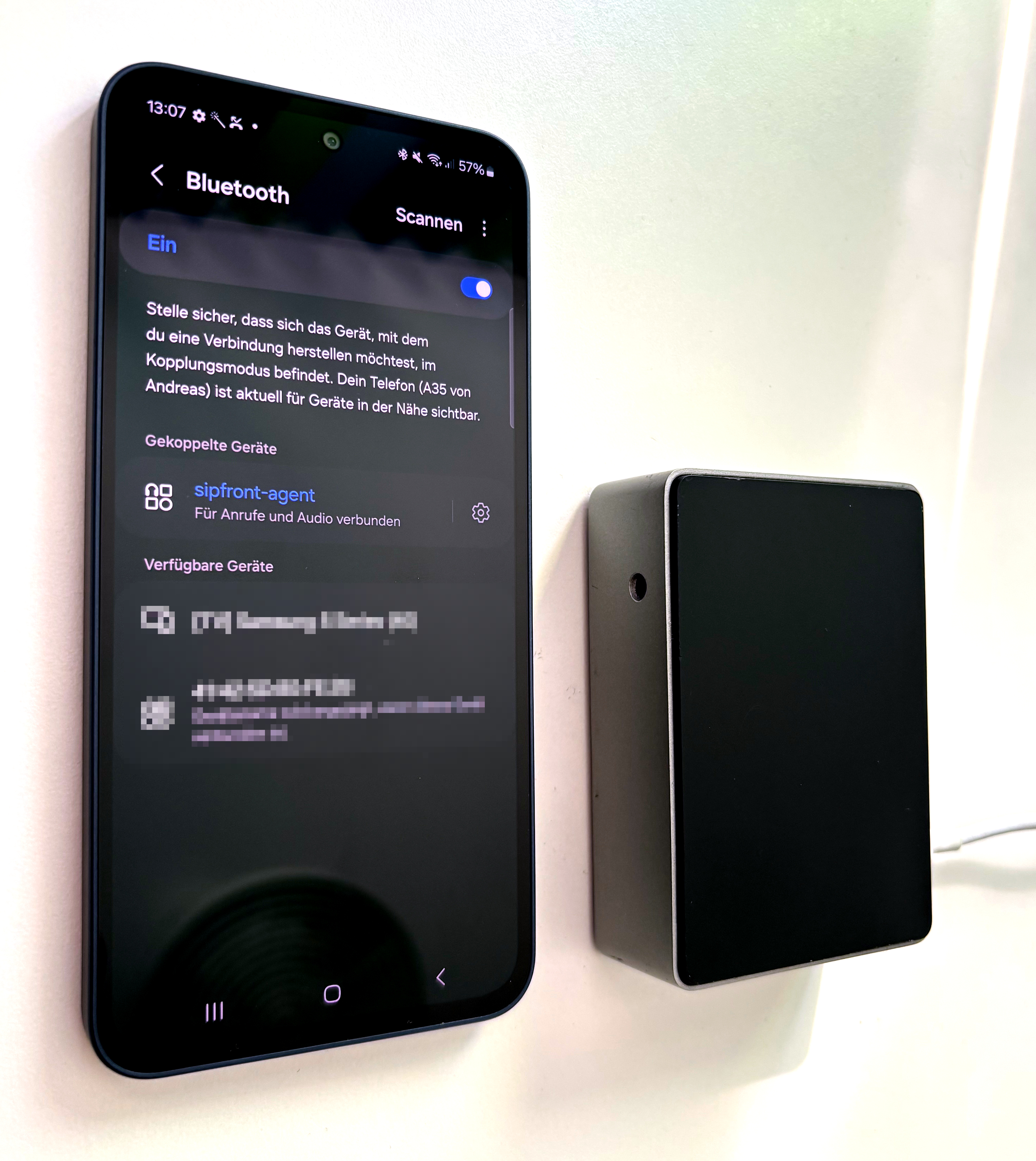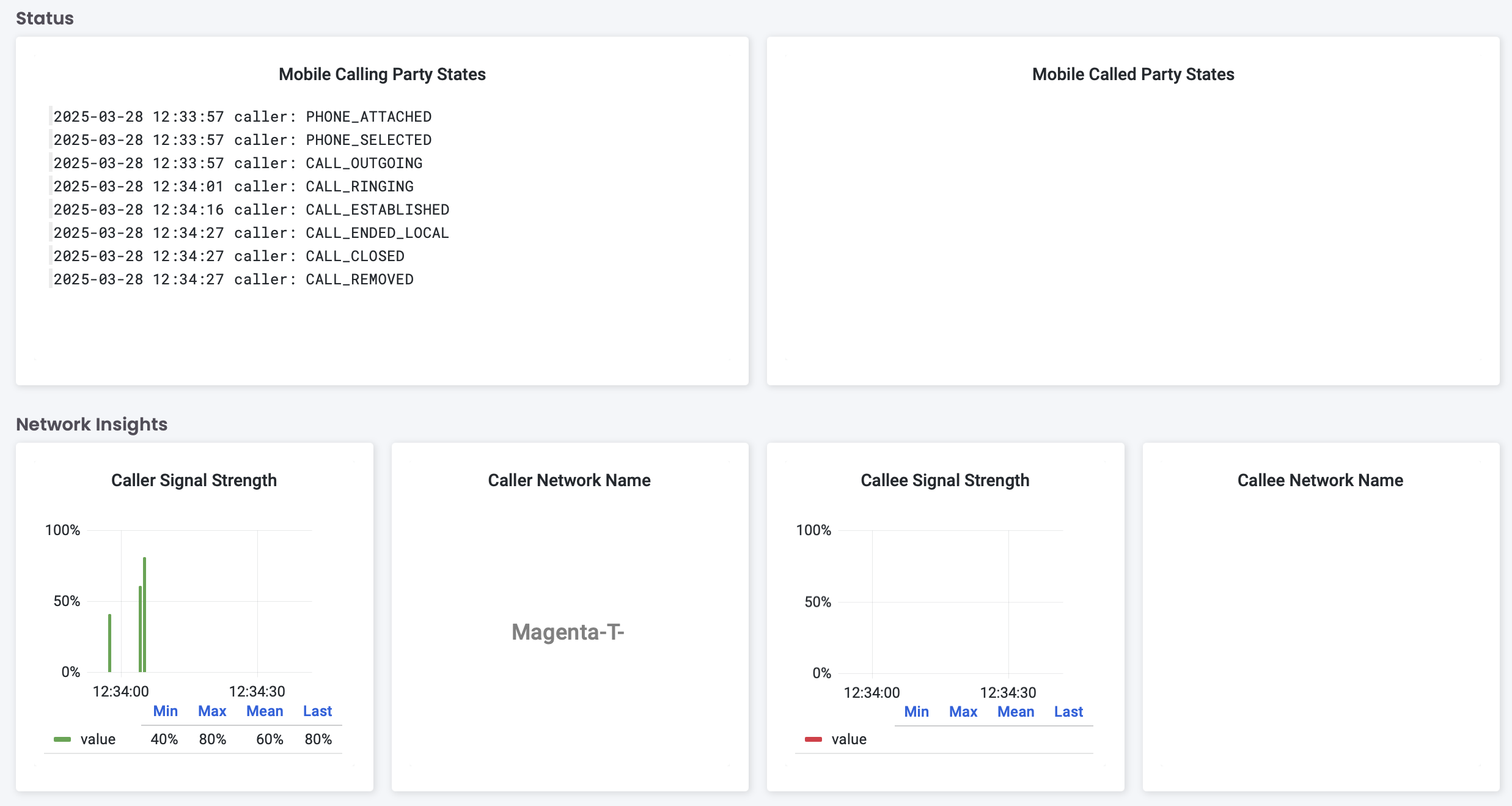Mobile Phone Tests¶
Sipfront provides the ability to integrate real mobile devices into your test scenarios. This is achieved by running a Raspberry Pi with a specific Sipfront image in your premises, and connect your phones to that device via Bluetooth.
With this approach, you can test calls from SIP or WebRTC via your peerings to the mobile network and vice versa, utilizing the radio technology your phones are attached to, such as 4G or 5G.
Important
Use agent group names without whitespace when using the Raspberry Pi for mobile tests and do not boot from a USB stick.
Requirements¶
- Raspberry Pi 4 or 5 with 8GB of RAM
- An 8GB (or larger) microSD card
- Any phone (Android, Apple, ...) with Hands-Free support via Bluetooth (any reasonably newish phone with Bluetooth should work)
Installation¶
- Download the latest Sipfront image for Raspberry Pi from the Sipfront CDN.
- Flash the image onto the microSD card using a tool like Balena Etcher. Check our Generic Raspberry Pi Installation Guide for more details.
- Reinsert the microSD card using your SD card reader on your machine where you flashed the image (it will show as
bootfsin your drives list) and opensipfront.txtwith a text editor. - Set the following configuration. If you did not yet create a custom agent pool, do so first in the Account > Agent Pools menu.
# the device will be accessible in your LAN via $AGENT_HOSTNAME.local
AGENT_HOSTNAME="sipfront-agent"
# fill in your Sipfront agent credentials
AGENT_POOL_ID="your-pool-id"
AGENT_POOL_SECRET="your-pool-secret"
AGENT_POOL_GROUP="raspi"
AGENT_POOL_IMAGE="sipfront/agent:mobile-driver"
# fill in your WiFi credentials to enable wifi
AGENT_WIFI_SSID="your-wifi-ssid"
AGENT_WIFI_PASSWORD="your-wifi-pass"
# set to yes to enable mobile phone testing via bluetooth
AGENT_PHONE_DRIVER="yes"
# set http proxy if needed, otherwise leave empty
AGENT_PROXY=""
If everything went fine, you should see your agent (listed as raspi if you used the configuration above) online in the Account > Agent Pools menu.
Note
If you connect the Raspberry Pi to your network via Ethernet, you can skip the WiFi configuration by keeping the AGENT_WIFI_SSID and AGENT_WIFI_PASSWORD empty.
Connecting your phone¶
iPhones¶
- On your phone, navigate to
Settings > Bluetoothand enable Bluetooth. - In the list of available devices, you should see
sipfront-agent(or theAGENT_HOSTNAMEyou set in thesipfront.txtconfig file) listed. Tap on it to connect. - If it asks you to allow syncing contacts etc., allow it.
Note
The sipfront agent will NOT download any contacts or personal information from your phone, nor use it in any way.
Android Phones¶
- On your phone, navigate to
Settings > Connections > Bluetoothand enable Bluetooth. - In the list of available devices, you should see
sipfront-agent(or theAGENT_HOSTNAMEyou set in thesipfront.txtconfig file) listed. Tap on it to connect. - If it asks you to allow syncing contacts etc., allow it.
Note
The sipfront agent will NOT download any contacts or personal information from your phone, nor use it in any way.
Warning
If you have trouble connecting your phone to the Raspberry Pi, e.g. it says it cannot connect via Bluetooth, make sure to disconnect the device from the sipfront-agent (use ignore device or something similar in your bluetooth settings) in case the Raspberry Pi was previously connected to the phone.

Create your first test¶
- In the Sipfront app, navigate to an existing test project or create a dedicated project for your mobile phone tests.
- Click the
Create new testbutton at the top. - Give it a descriptive name and description.
- Select the
Mobile call - Calling Party Onlytest scenario, which is the most simple mobile test to start with. - Under
Choose agent pool, select the agent pool you configured in yoursipfront.txtRaspberry Pi configuration file. - Under
Agent Groupin theConfigure your callerselectraspi(or the group you defined inAGENT_POOL_GROUPin yoursipfront.txt). Note that the group only becomes available once the Sipfront agent on your Raspberry Pi is online. If it's missing, it's a good indicator that there is a general configuration problem with the Raspberry Pi. - Enter the phone number you'd like to call in the
Dial Destionationfield of the section below, and optionally adapt theStop after time limit(e.g. setting it to30for a first quick test). - At the bottom, click
Save & Run.
This should trigger the test to run, and you should see the phone coming to life automatically after a few seconds, displaying the native dialer screen and showing the call being placed to the destination number you specified.

Warning
Since audio is running via bluetooth, you might experience distortions in the audio if both parties are talking at the same time. This is something we are working on to improve in the future, possibly by injecting and recording audio via a USB connection between the phones and the Raspberry Pi.
To temporarily overcome this issue e.g. for voice quality tests, it's best to utilize the call actions and mute audio on one end while playing audio on the other end.